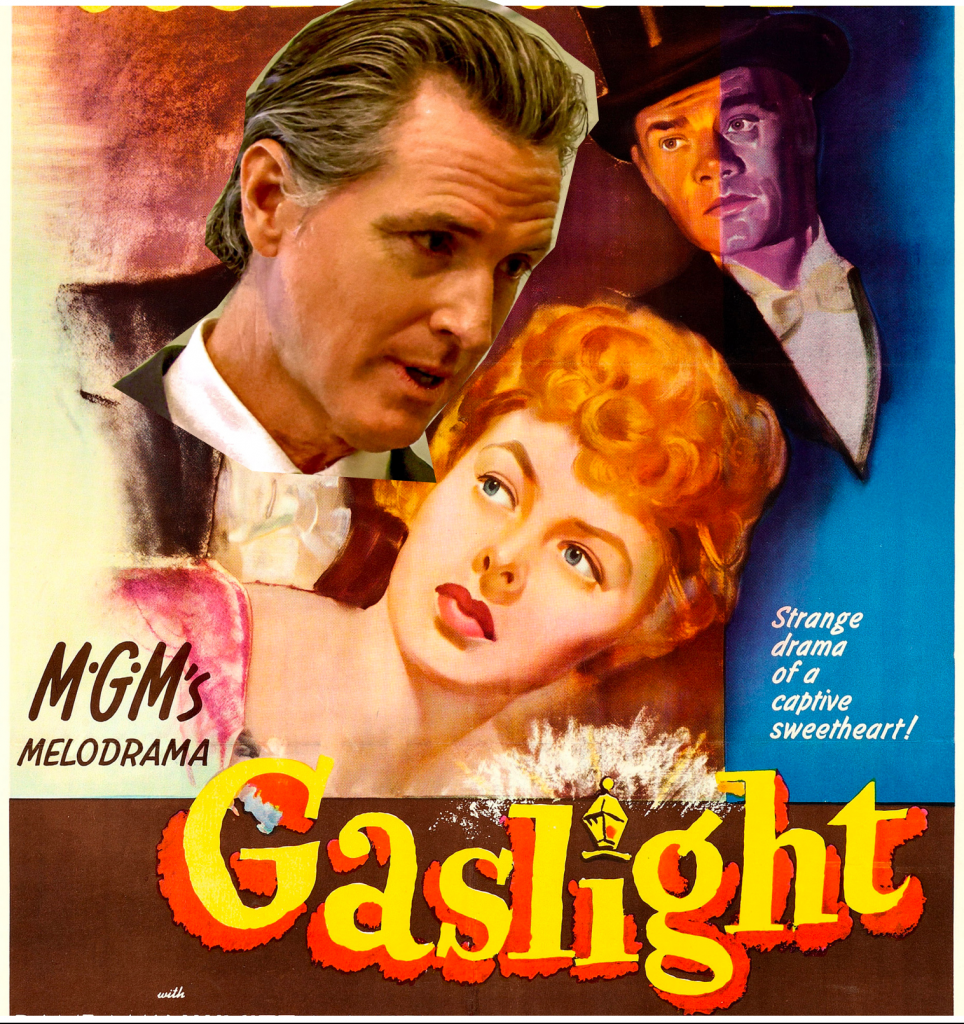How do politicians get away with blaming others for the consequences of their policies?
By Michael Shellenberger
More From Michael Shellenberger

In response to $6 per gallon gasoline prices, which are nearly 70% higher than the $3.81 national average, California Governor Gavin Newsom will convene a special session of the state legislature in December to enact a “windfall profits tax” on oil companies that he said are price gouging.
“Crude oil prices are down but oil and gas companies have jacked up prices at the pump in California,” said Newsom. “This doesn’t add up. We’re not going to stand by while greedy oil companies fleece Californians.”
But there is no evidence of illegal price setting, and a new tax on oil companies would increase prices further.
Last week, a federal judge in San Diego issued a 103-page ruling dismissing a class-action lawsuit that claimed traders at oil companies had colluded to keep prices high. The scope of the case was massive and spanned seven years of litigation.
As for a new tax, a 2006 report by the nonpartisan Congressional Research Service found that a new windfall profit tax on oil companies, which had been in place in the 1980s, would have “adverse economic effects,” including higher prices, lower domestic production, and increased foreign imports.
The San Diego judge did find that oil companies had coordinated refinery operations, and it may be appropriate for governments to impose a tax on a company when it is engaged in monopolistic or cartel behavior.
But the San Diego judge found no evidence that oil refiners deliberately create shortages to raise prices. “Antitrust wrongdoing consists of concerted action pursuant to an illegal agreement, not independent profit-maximizing actions based on market conditions,” she wrote.
And anti-trust regulations are well-enforced. “They definitely cannot talk to each other about their production time,” said UC Berkeley energy economist, Severin Borenstein. “That would be a pretty clear antitrust violation.”
The underlying problem is that California has reduced the capacity of its oil refineries as part of its push to phase out internal combustion engines. “California policymakers have knowingly adopted policies with the expressed intent of eliminating the refinery sector,” wrote the vice president of California refinery, Valero, in a letter [pdf] to the California Energy Commission.
Independent experts agree. “We’re operating now in a … tight market,” said Shon Hiatt, a University of Southern California associate professor of business. “So if one refinery goes off to do maintenance, the prices are going to jump, because we don’t have much slack.”
Indeed, those experts have been warning California policymakers for decades that the state lacked refinery capacity. A 2000 report by the state’s attorney general pointed to constraints on supply for California’s “unique clean-burning gasoline,” and higher taxes as the reason for the state’s higher prices.
“The way we’re doing it now is you just let the fuel costs go up and then we leave poor people with no ability to get anywhere,” said Tufts energy expert, Amy Myers Jaffe. “And then [California leaders] grandstand against the oil companies — that’s not a solution.”
If Newsom and other politicians really wanted to lower gasoline prices, economists say, they would expand refinery production and cut taxes. “If the goal is to help Californians hit specifically by high gas prices,” noted Borenstein, “nothing will be nearly as well targeted as a gas tax holiday.”
And increasing oil production in the U.S. would lower prices, just as it did over the last decade, after the shale fracking revolution.
But neither Newsom nor anyone one else in his party, which holds a super-majority in the state legislature, is proposing to expand refinery capacity, cut taxes, or expand production.
On the contrary. They are phasing out oil and gas production. In April and October 2021, Newsom ordered new regulations to end fracking in 2024 and restrict oil drilling. In August and September of this year, Newsom’s Air Resources Board announced a ban on internal combustion engine vehicles by 2035 and a ban on natural gas furnaces and water heaters by 2030.
Newsom’s actions are mirrored at the federal level. In May, President Joe Biden’s EPA shut down a large oil refinery in the U.S. Virgin Islands that investors had wanted to upgrade to make less polluting. Biden has leased less federal land and off-shore areas than any president since World War II. And he and his cabinet officials have repeatedly said their goal is to “end fossil fuel.”
At the same time, Biden, his cabinet, and his spokespersons have turned around and blamed gas station owners, refineries, and oil producers, for high gasoline prices. In June, Biden accused oil refiners of price gouging even though they were operating at 94% of their capacity. And he said, “This idea that [the oil and gas firms] don’t have oil to drill and to bring up is simply not true.” But it was true.
Then, before the July 4 weekend, Biden blamed the owners of gas stations, a competitive retail industry, for high prices. And administration officials said they killed a large Alaska oil and gas lease due to “lack of industry interest,” which was also not true, as Alaska’s senior senator pointed out.
This has been going on for decades. In 2006, Congressional Democrats killed federal legislation to increase refinery capacity and then turned around and blamed the industry for restricting supplies. “They thrive in an environment where markets are tight,” said Rep. Ed Markey (D-MA), who is today a Senator.
The same year, Senate Democrats killed legislation to expand oil production. “We need lower gas prices and energy independence,” said the late Senator Harry Reid. “Republican leaders have proposed the same old solution: drill, drill, drill. But drill, drill, drill is not going to deliver the results we need.” In fact, it was drill, drill, drill (and frack, frack, frack) that resulted in the US becoming the world’s largest oil producer in 2018.
Republicans tried again to expand refinery capacity in 2008, only to face the now-familiar argument from Democrats that oil companies were manipulating supply to keep prices high. “It’s been more than 30 years since America built its last new refinery,” said then-President George W. Bush. Responded Senator Dick Durbin (D-IL). “Don’t buy this agreement that it’s about refineries. They have more capacity that they’re holding back, so that they can keep their product dear and limited and short, and so that the consumers will ultimately pay more.”
In other words, Newsom, Biden, Markey, Reid, Durbin, and countless other politicians have been, for decades, gaslighting the American people. They have restricted oil production and refining capacity and then turned around and claimed it is the oil industry, not them, that is restricting capacity and refusing to produce, in order to keep oil prices high.
Their claims are belied by reality. The oil and gas industry eagerly expanded production between 2010 and 2020 by fracking so much shale that many of them went bankrupt because prices were so low for so long. And the oil and gas industry has long sought to expand refinery production and been thwarted by opposition at the local, state, and federal levels.
Half the time, the gaslighting doesn’t make any sense. Markey in 2006 accused the oil companies, which were seeking to expand refining capacity, of trying to restrict supply. Reid the same year said that increasing supply would not lower prices. In both cases, politicians have effectively told the public not to believe their lying eyes.
The question is not why Democrats gaslight on gas prices but why it works. Democrats have, for decades, made clear that they want to shut down the oil and gas industry. Biden promised it repeatedly on the campaign trail. His cabinet secretaries, most recently Treasury Secretary Janet Yellen, regularly emphasize their goal to phase out fossil fuels. But then, when prices rise, they are still able to convince a significant number of voters that it’s the fault of the oil companies. Why is that?
One reason it’s easy for politicians to demonize oil companies and gas stations is that they are the ones charging consumers and profiting when prices rise. They are a much more immediate villain than the past policies and the politicians, some of whom are dead or no longer in office, who created them.
And many voters don’t understand supply and demand, even if Democratic members of Congress do. “If there was a war on energy, how is Exxon, Chevron, BP and Shell making over 200% profits?” Rep. Ro Khanna (D-Calif.) asked me, rhetorically, in last month’s Congressional hearing. “You can’t have a war on an industry and then they’re having record profits.”
The reason, I told Khanna, is precisely because the Biden administration has been stifling oil and natural gas production, thereby reducing supplies, and increasing prices and profits.
While I believe Khanna understands perfectly well how supply and demand work, and that he was gaslighting me in the same way Democrats have been gaslighting for decades, I also think many voters find his claims persuasive, particularly when nobody is in the room to push back against them.
And, let’s face it, people want to believe it’s the fault of the oil companies. People don’t like oil companies for other various reasons. Oil spills are a highly visual case of environmental destruction. Oil refineries are dirty and pollute the poorer minority communities that live near them. And the high amount of price volatility compared to other products creates a sense that somebody is manipulating the market. Given how many reasons people have for disliking oil companies, it’s a short step to blaming them for high pries.
Resentment against oil companies is aided by the public’s belief that there is a significantly better way to power cars and trucks than gasoline and diesel. This view has, for the public, been confirmed by electric cars, which the media and most automakers believe will be widely adopted in the near future, even if there are many good reasons to believe they won’t be.
What can be done to push back against the gaslighting? One key, I believe, is showing the pattern of behavior, which was my motivation for writing this article. People need to see that the war on oil and gas, like the war on nuclear, has been going on for a long time, and that the people who are waging it disingenuously deny responsibility for its consequences, namely energy shortages and high prices.
Pointing out the gaslighting, in my experience, frequently provokes a defensive reaction from the people who have been gas-lit. They seek out additional reasons for how the oil and gas or nuclear energy companies are to blame for inadequate supplies. And they find reasons to dismiss the people who are pointing out the gaslighting.
But after the seeds have been planted in people’s minds, I find they greet new instances of gas-lighting with greater suspicion. People want to blame the oil companies but people don’t want to be duped by politicians, either.
It helps when other credible individuals point to the obvious. One of those individuals is JP Morgan CEO Jamie Dimon. Several weeks ago, he told members of Congress that shutting down the oil and gas industry would be a “road to hell.” He doubled down on his remarks on Monday, following Saudi Arabia’s oil production cut.
“Obviously, America needs to play a real leadership role — America is the swing producer, not Saudi Arabia,” he told CNBC. “We should have gotten that right starting in March. In my view, America should have been pumping more oil and gas and it should have been supported.”
“This is the chance to get our act together and to solidify the Western, free, democratic, capitalist, free people, free movements, freedom of speech, free religion for the next century,” said Dimon. “Because if we don’t get this one right, that kind of chaos you can see around the world for the next 50 years.”
The CEO of Toyota has also pushed back against the “all-electric” anti-gasoline demands of politicians. Toyota announced it would keep selling gas-powered cars as a major part of its lineup. Electric vehicles “are just going to take longer than the media would like us to believe,” said CEO Akio Toyoda, the grandson of the company’s founder. “That’s our strategy and we’re sticking to it,” he said.
The average electric vehicle price in the United States is $66,000, or $12,000 more than the median salary, and the costs of replacing electric vehicle batteries after ten years are very high. To replace a battery for a Tesla, Mustang, and Volt costs, respectively $15,000, $23,000, and $29,000.
Now, battery prices are rising. That’s due in part to the fact that lithium, cobalt, and nickel, the key materials in batteries, have soared to record highs. Lithium costs $71,315 per ton which is three times higher than last year.
All of this matters because the conceit behind Newsom’s war on oil refineries, internal combustion vehicles, and oil and gas production, is that we will soon not need any of them. Clearly, many people want to believe this is true. But the push for electric vehicles will soon crash into a wall of physics, economics, and national security.
In the meantime, pro-abundance environmentalists, consumer advocates, and anyone concerned about national security need to push back against the gaslighting. When Newsom claims, “Crude oil prices are down but oil and gas companies have jacked up prices at the pump in California,” we need to point out the real causes.
There is one thing we might agree with him on: “This doesn’t add up.”
More From Michael Shellenberger
Share This:




 CDN NEWS |
CDN NEWS |  US NEWS
US NEWS 


























